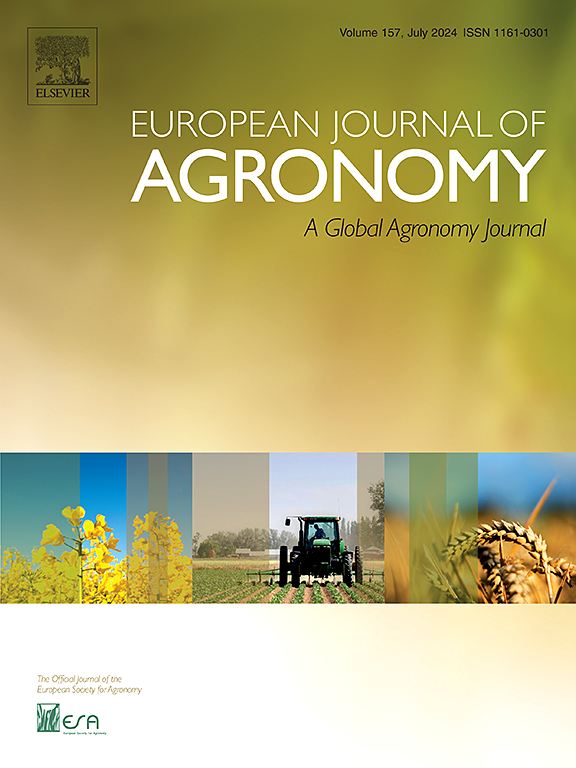长期施磷肥条件下,不同水稻质地土壤磷形态的变化影响土壤锌有效性
IF 4.5
1区 农林科学
Q1 AGRONOMY
引用次数: 0
摘要
磷(P)和锌(Zn)的相互作用对作物产量和养分有效性有显著影响。本研究在一个长期试验田研究了20年(2003-2022年)期间,水稻长期施磷肥对三种不同土壤质地(沙土、壤土和粘土)土壤磷形态和锌动态的影响。长期施磷肥增加了全磷、奥尔森磷和各磷组分,其中全磷(201.13 mg kg−1)和全无机磷(77.46 mg kg−1)增幅最大。施磷肥提高了壤土、粘土和沙土的有效锌含量(AZn)和有效锌指数(AIZn),降低了总锌(TZn)。AZn和AIZn含量的变化与土壤Olsen-P和特定P组分(CaCl2-P、Ca2-P和水溶性P)含量的变化呈正相关,籽粒去除Zn含量(△籽粒RZn)在0.023 ~ 0.045 kg hm−2之间,与土壤储存Olsen-P(△SOlsen-P)有关的粘土和沙土中显著增加,壤土中随着△SOlsen-P的增加而降低。冗余分析发现,土壤储存量AZn、Ca2-P和水溶性P的变化是影响籽粒去除Zn和P含量变化的重要因素(△籽粒RZn和△籽粒RP)。本研究强调了不同土壤结构中磷形态与锌有效性之间的复杂相互作用,对稻田长期磷肥施用具有重要意义。本文章由计算机程序翻译,如有差异,请以英文原文为准。
Changes in soil phosphorus forms affect soil zinc availability in distinct paddy rice soil textures under long-term phosphate fertilization
The interaction between phosphorus (P) and zinc (Zn) significantly impacts crop yield and nutrient availability in agricultural systems. This study examines how long-term P fertilization in paddy rice affects soil P forms and Zn dynamics across three distinct soil textures (sand, loam, and clay) over 20 years (2003–2022) in a long-term experimental field. Long-term P fertilization increased total P (TP), Olsen-P, and various P fractions, with clay soils showing the highest increases in TP (201.13 mg kg−1) and total inorganic P (77.46 mg kg−1). P fertilizer application enhanced available Zn content (AZn) and the available index of Zn (AIZn) while total Zn (TZn) decreased in loam, clay and sand soils. Changes in AZn and AIZn content were positively correlated with alterations in soil Olsen-P and specific P fractions content (CaCl2-P, Ca2-P, and water-soluble P). Grain removed Zn content (△Grain RZn) ranged from 0.023 to 0.045 kg hm−2, with significantly increases in clay and sand soils linked to soil storage Olsen-P (△SOlsen-P), while it decreased in loam soils with increasing △SOlsen-P. Redundancy analysis identified changes in soil storage AZn, Ca2-P, and water soluble P as significant factors influencing changes in grain removed Zn and P content (△Grain RZn and △Grain RP). This study highlights the complex interactions between P forms and Zn availability in different soil textures, with important implications for long-term phosphate fertilization practices in paddy fields.
求助全文
通过发布文献求助,成功后即可免费获取论文全文。
去求助
来源期刊

European Journal of Agronomy
农林科学-农艺学
CiteScore
8.30
自引率
7.70%
发文量
187
审稿时长
4.5 months
期刊介绍:
The European Journal of Agronomy, the official journal of the European Society for Agronomy, publishes original research papers reporting experimental and theoretical contributions to field-based agronomy and crop science. The journal will consider research at the field level for agricultural, horticultural and tree crops, that uses comprehensive and explanatory approaches. The EJA covers the following topics:
crop physiology
crop production and management including irrigation, fertilization and soil management
agroclimatology and modelling
plant-soil relationships
crop quality and post-harvest physiology
farming and cropping systems
agroecosystems and the environment
crop-weed interactions and management
organic farming
horticultural crops
papers from the European Society for Agronomy bi-annual meetings
In determining the suitability of submitted articles for publication, particular scrutiny is placed on the degree of novelty and significance of the research and the extent to which it adds to existing knowledge in agronomy.
 求助内容:
求助内容: 应助结果提醒方式:
应助结果提醒方式:


